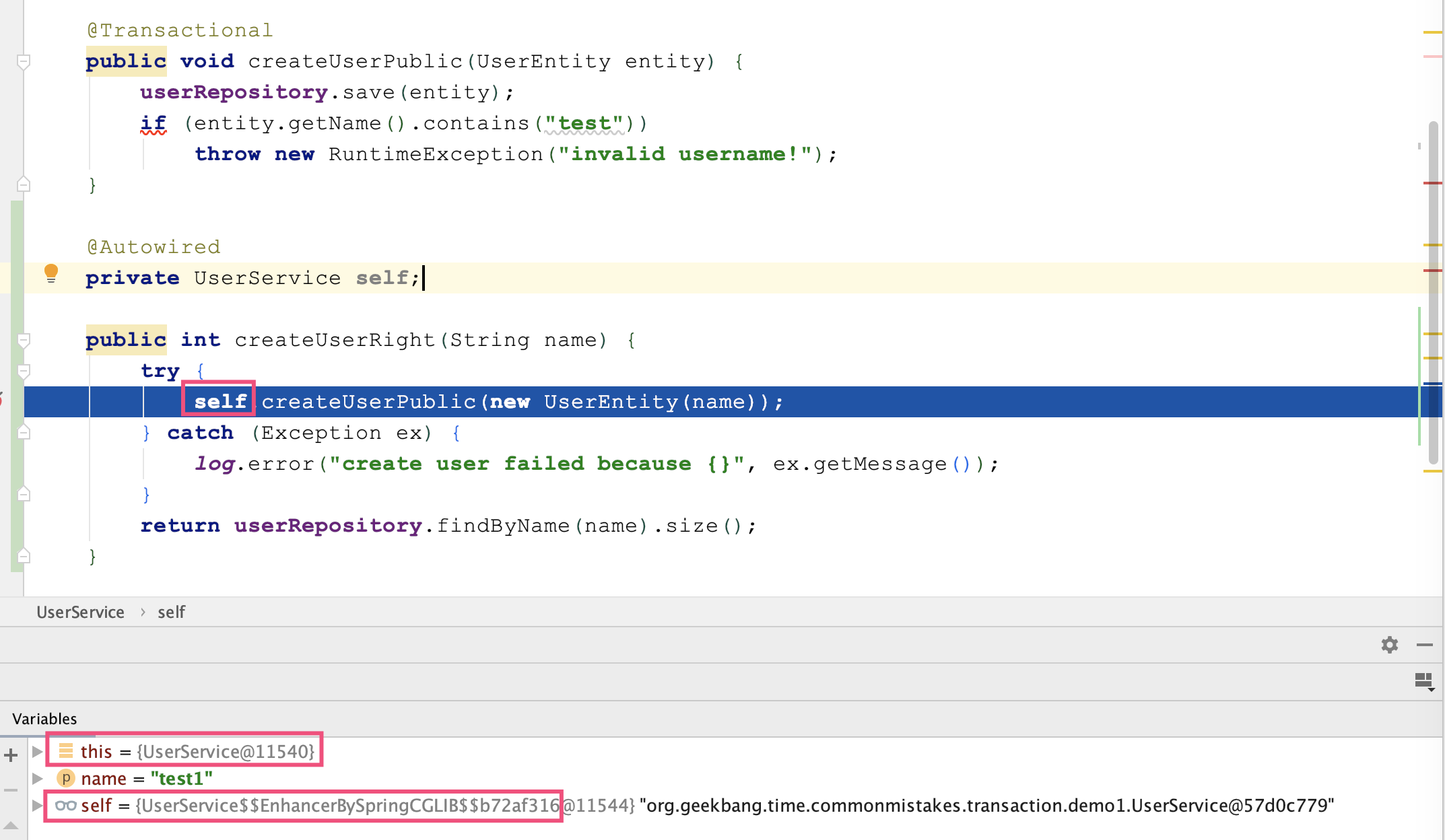Spring 针对 Java Transaction API (JTA)、JDBC、Hibernate 和 Java Persistence API (JPA) 等事务 API,实现了一致的编程模型,而 Spring 的声明式事务功能更是提供了极其方便的事务配置方式,配合 Spring Boot 的自动配置,大多数 Spring Boot 项目只需要在方法上标记 @Transactional 注解,即可一键开启方法的事务性配置。
写法一:
@Service@Slf4jpublic class UserService { @Autowired private UserRepository userRepository;
//一个公共方法供Controller调用,内部调用事务性的私有方法 public int createUserWrong1(String name) { try { this.createUserPrivate(new UserEntity(name)); } catch (Exception ex) { log.error("create user failed because {}", ex.getMessage()); } return userRepository.findByName(name).size(); }
//标记了@Transactional的private方法 @Transactional private void createUserPrivate(UserEntity entity) { userRepository.save(entity); if (entity.getName().contains("test")) throw new RuntimeException("invalid username!"); }
//根据用户名查询用户数 public int getUserCount(String name) { return userRepository.findByName(name).size(); }}
复制代码
@Transactional 生效原则 1,除非特殊配置(比如使用 AspectJ 静态织入实现 AOP),否则只有定义在 public 方法上的 @Transactional 才能生效
写法二:
public int createUserWrong2(String name) { try { this.createUserPublic(new UserEntity(name)); } catch (Exception ex) { log.error("create user failed because {}", ex.getMessage()); } return userRepository.findByName(name).size();}
//标记了@Transactional的public方法@Transactionalpublic void createUserPublic(UserEntity entity) { userRepository.save(entity); if (entity.getName().contains("test")) throw new RuntimeException("invalid username!");}
复制代码
@Transactional 生效原则 2,必须通过代理过的类从外部调用目标方法才能生效
事务即便生效也不一定能回滚
通过 AOP 实现事务处理可以理解为,使用 try…catch…来包裹标记了 @Transactional 注解的方法,当方法出现了异常并且满足一定条件的时候,在 catch 里面我们可以设置事务回滚,没有异常则直接提交事务。
这个的一定条件满足以下两条:
try { // This is an around advice: Invoke the next interceptor in the chain. // This will normally result in a target object being invoked. retVal = invocation.proceedWithInvocation();}catch (Throwable ex) { // target invocation exception completeTransactionAfterThrowing(txInfo, ex); throw ex;}finally { cleanupTransactionInfo(txInfo);}
复制代码
/** * The default behavior is as with EJB: rollback on unchecked exception * ({@link RuntimeException}), assuming an unexpected outcome outside of any * business rules. Additionally, we also attempt to rollback on {@link Error} which * is clearly an unexpected outcome as well. By contrast, a checked exception is * considered a business exception and therefore a regular expected outcome of the * transactional business method, i.e. a kind of alternative return value which * still allows for regular completion of resource operations. * <p>This is largely consistent with TransactionTemplate's default behavior, * except that TransactionTemplate also rolls back on undeclared checked exceptions * (a corner case). For declarative transactions, we expect checked exceptions to be * intentionally declared as business exceptions, leading to a commit by default. * @see org.springframework.transaction.support.TransactionTemplate#execute */@Overridepublic boolean rollbackOn(Throwable ex) { return (ex instanceof RuntimeException || ex instanceof Error);}
复制代码
写法三:
@Service@Slf4jpublic class UserService { @Autowired private UserRepository userRepository; //异常无法传播出方法,导致事务无法回滚 @Transactional public void createUserWrong1(String name) { try { userRepository.save(new UserEntity(name)); throw new RuntimeException("error"); } catch (Exception ex) { log.error("create user failed", ex); } }
//即使出了受检异常也无法让事务回滚 @Transactional public void createUserWrong2(String name) throws IOException { userRepository.save(new UserEntity(name)); otherTask(); }
//因为文件不存在,一定会抛出一个IOException private void otherTask() throws IOException { Files.readAllLines(Paths.get("file-that-not-exist")); }}
复制代码
改动一:
@Transactionalpublic void createUserRight1(String name) { try { userRepository.save(new UserEntity(name)); throw new RuntimeException("error"); } catch (Exception ex) { log.error("create user failed", ex); TransactionAspectSupport.currentTransactionStatus().setRollbackOnly(); }}
复制代码
改动二:
@Transactional(rollbackFor = Exception.class)public void createUserRight2(String name) throws IOException { userRepository.save(new UserEntity(name)); otherTask();}
复制代码
我们期望子用户的注册作为一个事务单独回滚,不影响主用户的注册,这样的逻辑可以实现吗?
代码实现:
//设置 REQUIRES_NEW 方式的事务传播策略,也就是执行到这个方法时需要开启新的事务,并挂起当前事务@Transactional(propagation = Propagation.REQUIRES_NEW)public void createSubUserWithExceptionRight(UserEntity entity) { log.info("createSubUserWithExceptionRight start"); userRepository.save(entity); throw new RuntimeException("invalid status");}
@Transactionalpublic void createUserRight(UserEntity entity) { createMainUser(entity); try{ subUserService.createSubUserWithExceptionRight(entity); } catch (Exception ex) { // 捕获异常,防止主方法回滚 log.error("create sub user error:{}", ex.getMessage()); }}
复制代码
transactionService.execTransaction(() -> { ActivityBatch activityBatch1 = new ActivityBatch(); activityBatch1.setId(activityBatchId); activityBatch1.setIsCancelTime(YN.Y.getCode()); activityBatch1.setBatchLockStatus(ActivityBatchLockStatusEnum.BATCH_LOCK_STATUS_CLOSE.getCode()); activityBatchMapper.updateById(activityBatch1); activityBatchMapper.batchDeleteByIds(editor, Lists.newArrayList(activityBatchId)); activityBatchSpecPriceMapper.cancelByBatchId(editor, batchId, activityId, HmcOperationTypeEnum.HMC_CANCEL_ACTIVITY_BATCH.name()); return true;});
复制代码
总结一下就是:
1、事务慎用;
2、事务内部严禁 RPC 调用;
3、事务注解需要显式指定 rollbackFor 的异常;
4、事务要保持原子性;













评论